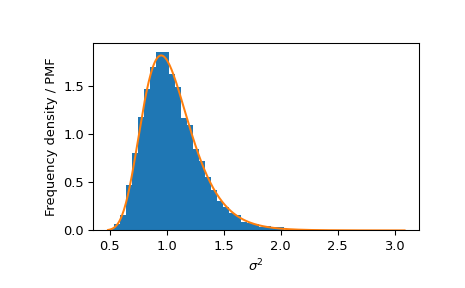scipy.stats.normal_inverse_gamma#
- scipy.stats.normal_inverse_gamma = <scipy.stats._multivariate.normal_inverse_gamma_gen object>[source]#
Normal-inverse-gamma distribution.
The normal-inverse-gamma distribution is the conjugate prior of a normal distribution with unknown mean and variance.
- Parameters:
- mu, lmbda, a, barray_like
Shape parameters of the distribution. See notes.
- seed{None, int, np.random.RandomState, np.random.Generator}, optional
Used for drawing random variates. If seed is None, the RandomState singleton is used. If seed is an int, a new
RandomStateinstance is used, seeded with seed. If seed is already aRandomStateorGeneratorinstance, then that object is used. Default is None.
Methods
pdf(x, s2, mu=0, lmbda=1, a=1, b=1)
Probability density function.
logpdf(x, s2, mu=0, lmbda=1, a=1, b=1)
Log of the probability density function.
mean(mu=0, lmbda=1, a=1, b=1)
Distribution mean.
var(mu=0, lmbda=1, a=1, b=1)
Distribution variance.
rvs(mu=0, lmbda=1, a=1, b=1, size=None, random_state=None)
Draw random samples.
Notes
The probability density function of
normal_inverse_gammais:\[f(x, \sigma^2; \mu, \lambda, \alpha, \beta) = \frac{\sqrt{\lambda}}{\sqrt{2 \pi \sigma^2}} \frac{\beta^\alpha}{\Gamma(\alpha)} \left( \frac{1}{\sigma^2} \right)^{\alpha + 1} \exp \left(- \frac{2 \beta + \lambda (x - \mu)^2} {2 \sigma^2} \right)\]where all parameters are real and finite, and \(\sigma^2 > 0\), \(\lambda > 0\), \(\alpha > 0\), and \(\beta > 0\).
Methods
normal_inverse_gamma.pdfandnormal_inverse_gamma.logpdfaccept x and s2 for arguments \(x\) and \(\sigma^2\). All methods accept mu, lmbda, a, and b for shape parameters \(\mu\), \(\lambda\), \(\alpha\), and \(\beta\), respectively.Added in version 1.15.
References
[1]Normal-inverse-gamma distribution, Wikipedia, https://en.wikipedia.org/wiki/Normal-inverse-gamma_distribution
Examples
Suppose we wish to investigate the relationship between the normal-inverse-gamma distribution and the inverse gamma distribution.
>>> import numpy as np >>> from scipy import stats >>> import matplotlib.pyplot as plt >>> rng = np.random.default_rng() >>> mu, lmbda, a, b = 0, 1, 20, 20 >>> norm_inv_gamma = stats.normal_inverse_gamma(mu, lmbda, a, b) >>> inv_gamma = stats.invgamma(a, scale=b)
One approach is to compare the distribution of the s2 elements of random variates against the PDF of an inverse gamma distribution.
>>> _, s2 = norm_inv_gamma.rvs(size=10000, random_state=rng) >>> bins = np.linspace(s2.min(), s2.max(), 50) >>> plt.hist(s2, bins=bins, density=True, label='Frequency density') >>> s2 = np.linspace(s2.min(), s2.max(), 300) >>> plt.plot(s2, inv_gamma.pdf(s2), label='PDF') >>> plt.xlabel(r'$\sigma^2$') >>> plt.ylabel('Frequency density / PMF') >>> plt.show()

Similarly, we can compare the marginal distribution of s2 against an inverse gamma distribution.
>>> from scipy.integrate import quad_vec >>> from scipy import integrate >>> s2 = np.linspace(0.5, 3, 6) >>> res = quad_vec(lambda x: norm_inv_gamma.pdf(x, s2), -np.inf, np.inf)[0] >>> np.allclose(res, inv_gamma.pdf(s2)) True
The sample mean is comparable to the mean of the distribution.
>>> x, s2 = norm_inv_gamma.rvs(size=10000, random_state=rng) >>> x.mean(), s2.mean() (np.float64(-0.005254750127304425), np.float64(1.050438111436508)) >>> norm_inv_gamma.mean() (np.float64(0.0), np.float64(1.0526315789473684))
Similarly, for the variance:
>>> x.var(ddof=1), s2.var(ddof=1) (np.float64(1.0546150578185023), np.float64(0.061829865266330754)) >>> norm_inv_gamma.var() (np.float64(1.0526315789473684), np.float64(0.061557402277623886))